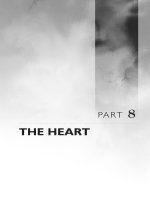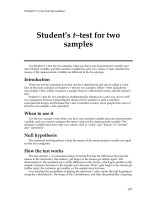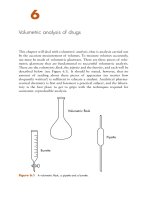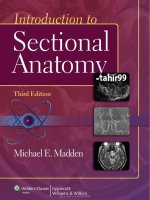Ebook ECG in medical practice (3rd edition): Part 1
Bạn đang xem bản rút gọn của tài liệu. Xem và tải ngay bản đầy đủ của tài liệu tại đây (8.63 MB, 120 trang )
ECG in Medical Practice
z.f
Concerned mainly with basic concepts,
abnormalities in cardiac disease and 150 tracings of ECG for practice
ECG in Medical Practice
Third Edition
ABM Abdullah
MRCP (UK), FRCP (Edin)
Professor of Medicine
Bangabandhu Sheikh Mujib Medical University
Dhaka, Bangladesh
®
JAYPEE BROTHERS MEDICAL PUBLISHERS (P) LTD
Kolkata • St Louis (USA) • Panama City (Panama) • London (UK) • Ahmedabad • Bengaluru
Chennai • Hyderabad • Kochi • Lucknow • Mumbai • Nagpur • New Delhi
Published by
Jitendar P Vij
Jaypee Brothers Medical Publishers (P) Ltd
Corporate Office
4838/24 Ansari Road, Daryaganj, New Delhi - 110002, India, Phone: +91-11-43574357, Fax: +91-11-43574314
Registered Office
B-3 EMCA House, 23/23B Ansari Road, Daryaganj, New Delhi - 110 002, India
Phones: +91-11-23272143, +91-11-23272703, +91-11-23282021, +91-11-23245672
Rel: +91-11-32558559, Fax: +91-11-23276490, +91-11-23245683
e-mail: , Website: www.jaypeebrothers.com
Offices in India
• Ahmedabad, Phone: Rel: +91-79-32988717, e-mail:
• Bengaluru, Phone: Rel: +91-80-32714073, e-mail:
• Chennai, Phone: Rel: +91-44-32972089, e-mail:
• Hyderabad, Phone: Rel:+91-40-32940929, e-mail:
• Kochi, Phone: +91-484-2395740, e-mail:
• Kolkata, Phone: +91-33-22276415, e-mail:
• Lucknow, Phone: +91-522-3040554, e-mail:
• Mumbai, Phone: Rel: +91-22-32926896, e-mail:
• Nagpur, Phone: Rel: +91-712-3245220, e-mail:
Overseas Offices
• North America Office, USA, Ph: 001-636-6279734, e-mail: ,
• Central America Office, Panama City, Panama
Ph: 001-507-317-0160, e-mail: , Website: www.jphmedical.com
• Europe Office, UK, Ph: +44 (0) 2031708910, e-mail:
ECG in Medical Practice
© 2010, Jaypee Brothers Medical Publishers
All rights reserved. No part of this publication should be reproduced, stored in a retrieval system, or transmitted in any form or
by any means: electronic, mechanical, photocopying, recording, or otherwise, without the prior written permission of the
author and the publisher.
This book has been published in good faith that the material provided by author is original. Every effort is made to ensure
accuracy of material, but the publisher, printer and author will not be held responsible for any inadvertent error (s). In case
of any dispute, all legal matters are to be settled under Delhi jurisdiction only.
First Edition: 2004
Second Edition: 2006
Third Edition: 2010
ISBN 978-81-8448-968-2
Typeset at JPBMP typesetting unit
Printed at Ajanta Offset
To
my parents
for their never-ending
blessings, love and encouragement
The value of experience is not in seeing much but in seeing wisely
—William Osler
Preface to the Third Edition
By the good grace of Almighty Allah and blessings of my well-wishers, I have been able to bring out the third edition of
this book. Immense popularity and wide acceptability of this book among the students and doctors have encouraged me
to prepare this edition.
While I have written this book, my intention was to improve the understanding and interpretation of common ECG
in an easy and simple way. Emphasis has been given on the importance of clinical correlation. To what extent this goal
has been achieved, only the valued readers and time will tell. However, I can assure that a sincere attempt has been made
by me to fulfill this purpose. Many new ECG tracings have been included in this present edition.
In spite of my best efforts, I believe there is still scope of further improvement of this book and make it even better.
Any constructive suggestions and criticisms will be highly welcomed and appreciated.
ABM Abdullah
Preface to the First Edition
Despite the advent of many high-tech diagnostic procedures, ECG still remains one of the most basic, useful and easily
available tools for the early diagnosis and evaluation of many cardiac problems.
In spite of lot of books on this topic, I have written another new book, which is simple, concise, easy and a practical
one that will help any physician, specially the beginners with little knowledge or experience on ECG.
The aim of this book is to guide the students and doctors about the basic concepts in ECG, its interpretation and
recognition of cardiac abnormalities. It is also my intention to include common abnormalities in ECG and common
cardiac problems that will help the students in any specialty of medicine, specially those who will appear in any
examination.
To simplify and also to practice, I have arranged this book in three chapters:
• Chapter I—contains the basic principles of ECG along with normal ECG pattern and the abnormalities.
• Chapters II—contains the ECG abnormalities in different cardiac and extra-cardiac diseases.
• Chapter III—contains 100 ECG tracings of varying difficulty (from simple to more complex) for self practice.
Interpretation of these ECG are written in the last few pages (I would advise first to interpret the ECG by yourself,
then compare the findings).
Whenever you are going through an ECG, always proceed systematically. Never leave anything to chance and never
assume anything. Always describe the basic things and finally look for any abnormality.
Being an internist, I have prepared this book after going through dozens of different ECG books and have tried my
best to fill up the gaps, I have noticed in those during my long teaching experience. It is my students and doctor colleagues
who have constantly inspired and insisted me to prepare such a book so that they can have a complete and easy grasp
over the topic in a short-time. I believe, this book will not only fulfill their demand, but also be of great help for those
who are willing to self-learn the basic concepts of ECG.
I was always careful not to overburden the busy clinicians and practitioners with the unnecessary details.
I would like to emphasise that efficiency, skill and fluency in interpreting ECG will only be achieved by going
through the ECG tracings repeatedly and reviewing the topics frequently.
I would always appreciate and welcome constructive criticism from the valued readers about this book.
ABM Abdullah
Acknowledgments
My heartiest gratitude and respect to those patients who were kind enough to agree to let me publish their ECG tracings
in this book.
I express my sincere gratitude to Prof Pran Gopal Datta, MCPS, ACORL (Odessa), PhD (Kiev), MSc in Audiology
(UK), FCPS, FRCS (Glasgow-UK), Vice Chancellor, Bangabandhu Sheikh Mujib Medical University, for his
encouragement and valuable suggestions in preparing this book.
I am also highly grateful to Dr Ahmed-Al-Muntasir-Niloy, Medical Officer, BSMMU, Dr Omar Serajul Hasan, MD,
internist (USA) and Dr Tanjim Sultana, MD, internist (USA). They have worked almost as co-authors, going through
the whole manuscript and making necessary corrections and modifications.
I also acknowledge the contribution of my colleagues, doctors and students who have helped me by providing
advice, corrections and encouragement:
• Prof N Islam, IDA, DSc, FRCP, FRCPE, FCGP, FAS, National Professor, Founder and Vice Chancellor, University
of Science and Technology, Chittagong.
• Prof Munir Uddin Ahmed, FRCP (London and Glasgow).
• Prof MN Alam, FRCP (Glasgow), FCPS.
• Prof Tofayel Ahmed, FCPS (BD), FCPS (Pak), FCCP, FACP (USA), MRCP, FRCP (Edin, Glasgow, Ireland).
• Prof Md. Fazlul Hoque, FCPS (BD), FRCP (Edin), FRCP (Glasgow), FCPS (Pak), FACP (USA).
• Prof MU Kabir Chowdhury, FRCP (Glasgow).
• Prof Md. Gofranul Hoque, FCPS.
• Prof Taimur AK Mahmud, MCPS, FCPS.
• Prof Md Abdul Wahab, DTCD, MRCP, FRCP.
• Dr Tahmida Hassan, DDV, MD.
• Dr Tazin Afrose Shah, FCPS.
• Dr Shahnoor Sharmin, MCPS, FCPS, MD (Cardiology)
• Dr Md. Razibul Alam, MBBS, MD.
• Dr Samprity Islam, MBBS.
• Dr Monirul Islam Khan, MBBS.
• Dr Sadi Abdullah, MBBS.
I would like to thank Mr Saiful Islam, Kh. Atiqur Rahman (Shamim) and Md. Oliullah for their great help in computer
composing and graphic designing of this book.
My special thanks to Shri Jitendar P Vij (Chairman and Managing Director), Mr Tarun Duneja (Director-Publishing),
Mr KK Raman (Production Manager), Mr Sunil Dogra, Mrs Yashu Kapoor, Mr Akhilesh Kumar Dubey and Mr Manoj
Pahuja of M/s Jaypee Brothers Medical Publishers (P) Ltd., who have worked tirelessly for the timely publication of this
book.
Last but not the least, I would like to express my gratitude to my wife and children for their constant support,
sacrifice and encouragement. Otherwise, it would have been impossible for me to write this book.
Contents
CHAPTER I: BASIC CONCEPTS OF ECG .............................................................................................................. 1
•
•
•
•
•
•
Specialized Conductive System of the Heart ............................................................................................................. 3
Anatomy of Conductive Tissues ................................................................................................................................. 4
Coronary Circulation .................................................................................................................................................. 5
Properties of Cardiac Muscles .................................................................................................................................... 6
Nerve Supply of the Heart .......................................................................................................................................... 6
Electrocardiogram ....................................................................................................................................................... 7
— Interpretation of ECG ............................................................................................................................................ 9
— Brief Discussion about ECG Paper ..................................................................................................................... 10
— Normal ECG ....................................................................................................................................................... 12
— Details of Waves and Intervals ............................................................................................................................ 14
– P-R Interval ................................................................................................................................................... 16
–
–
–
–
–
–
–
–
Q Wave .......................................................................................................................................................... 17
R Wave ........................................................................................................................................................... 18
S Wave ........................................................................................................................................................... 19
QRS Complex ................................................................................................................................................ 20
ST Segment ................................................................................................................................................... 22
T Wave ........................................................................................................................................................... 23
U Wave .......................................................................................................................................................... 24
QT Interval .................................................................................................................................................... 25
– Rhythm of Heart ............................................................................................................................................ 26
– Characters of Sinus Rhythm .......................................................................................................................... 26
– Calculation of Heart Rate .............................................................................................................................. 27
– Cardiac Axis .................................................................................................................................................. 28
– Normal Variants in ECG ................................................................................................................................ 30
– Exercise ECG (ETT) ..................................................................................................................................... 30
CHAPTER II: ECG CHANGES IN DIFFERENT DISEASES .............................................................................. 31
•
Left Ventricular Hypertrophy .................................................................................................................................... 33
•
Right Ventricular Hypertrophy ................................................................................................................................. 35
•
Biventricular Hypertrophy (LVH and RVH) ............................................................................................................ 36
•
Left Atrial Hypertrophy ............................................................................................................................................ 37
•
Right Atrial Hypertrophy .......................................................................................................................................... 38
•
Combined Left and Right Atrial Hypertrophy (Biatrial Hypertrophy) ..................................................................... 39
•
Atrial Fibrillation ...................................................................................................................................................... 40
•
Ashman Phenomenon ............................................................................................................................................... 43
xiv
ECG in Medical Practice
•
Artial Flutter ............................................................................................................................................................. 44
•
Ventricular Ectopic ................................................................................................................................................... 45
•
Ventricular Tachycardia ............................................................................................................................................ 47
•
Torsades De Pointes .................................................................................................................................................. 49
•
Ventricular Fibrillation .............................................................................................................................................. 50
•
Heart Block ............................................................................................................................................................... 51
•
SA Block ................................................................................................................................................................... 52
•
First Degree AV Block .............................................................................................................................................. 54
•
Second Degree AV Block ......................................................................................................................................... 55
•
Complete Heart Block (3rd Degree) ......................................................................................................................... 57
•
Atrioventricular Dissociation ................................................................................................................................... 59
•
Right Bundle Branch Block ...................................................................................................................................... 60
•
Fascicular Block (Hemiblock) .................................................................................................................................. 61
•
Left Bundle Branch Block ........................................................................................................................................ 63
•
Myocardial Infarction ............................................................................................................................................... 64
•
Acute Pericarditis ..................................................................................................................................................... 72
•
Wolff-Parkinson-White (WPW) Syndrome .............................................................................................................. 74
•
Lown-Ganong-Levine Syndrome ............................................................................................................................. 76
•
Sinus Arrhythmia ...................................................................................................................................................... 77
•
Sinus Tachycardia ..................................................................................................................................................... 78
•
Sinus Bradycardia ..................................................................................................................................................... 79
•
Supraventricular Tachycardia ................................................................................................................................... 80
•
Nodal Rhythm (Junctional Rhythm) ......................................................................................................................... 83
•
Atrial Tachycardia ..................................................................................................................................................... 84
•
Pacemaker ................................................................................................................................................................. 85
•
Digitalis (Digoxin) Effect ......................................................................................................................................... 89
•
Hypokalemia ............................................................................................................................................................. 91
•
Hyperkalemia ............................................................................................................................................................ 92
•
Pulmonary Embolism ................................................................................................................................................ 94
•
Dextrocardia ............................................................................................................................................................. 96
•
Electromechanical Dissociation ............................................................................................................................... 98
•
Hypothermia ............................................................................................................................................................. 99
•
COPD ....................................................................................................................................................................... 99
•
Hypermagnesemia ..................................................................................................................................................... 99
•
Hypomagnesemia ...................................................................................................................................................... 99
•
Atrial Septal Defect ................................................................................................................................................ 100
•
Hypothyroidism ...................................................................................................................................................... 100
•
Hyperthyroidism ..................................................................................................................................................... 100
•
Hypocalcemia ......................................................................................................................................................... 100
Contents
xv
•
Hypercalcemia ........................................................................................................................................................ 100
•
Pericardial Effusion ................................................................................................................................................ 101
•
Wandering Pacemaker ............................................................................................................................................ 102
•
Atrial Ectopic .......................................................................................................................................................... 103
•
Ventricular Bigeminy .............................................................................................................................................. 105
•
Ventricular Trigeminy ............................................................................................................................................. 106
•
Ventricular Quadrigeminy ...................................................................................................................................... 106
CHAPTER III: 150 TRACINGS OF ECG .............................................................................................................. 107
•
Findings of ECG Tracings ...................................................................................................................................... 259
Suggested Reading ................................................................................................................................................. 271
Index ..................................................................................................................................................................... 273
"Workout the best method for examination and
practice it until it is a second nature to you"
Standard Leads
Chest Leads
Basic Concepts of ECG
3
SPECIALIZED CONDUCTIVE SYSTEM OF THE HEART
There are 5 specialized tissues called conductive system of the heart. These are:
• SA node.
• AV node.
• Bundle of His.
• Right bundle branch (RBB) and left bundle branch (LBB).
• Purkinje fibers.
These specialized conductive pathways allow the heart to be electrically activated in a predictable manner (see the
sequence below).
The impulse arises in SA node (called primary pacemaker), spreads across the atria (by three internodal pathways
and Bachmann's bundle), causing depolarization of both atria. From the atria, the impulse reaches the AV node, where
there is some delay, which allow atria to contract and pump blood into the ventricles. The impulse then spreads along the
bundle of His, then along the left and right bundle branch, finally into the ventricular muscles through Purkinje fibers,
causing ventricular depolarization.
First the ventricular septum is activated, followed by the endocardium and finally the epicardium.
Sequence of impulse formation and conduction.
This is the normal sequence of stimulation of the specialized tissue. If any disturbance of this sequence occurs, there
is rhythm disturbance, called arrhythmia or abnormality of conduction, called heart block.
SA node is the dominant pacemaker. Other pacemaker sites in the heart are atria, AV node and ventricles. All these
are dormant, but can initiate impulse at a slow rate when SA node fails.
4
ECG in Medical Practice
ANATOMY OF CONDUCTIVE TISSUE
1. SA node: Located in the superior and right side of right atrium, near the root of superior vena cava. Normally, the
impulse arises in SA node called sinus rhythm. From SA node, impulse spreads along 3 internodal pathways (anterior,
middle and posterior) into both right and left atrium. Finally, these 3 internodal pathways enter into the AV node. An
additional internodal pathway called Bachmann's Bundle is present, which transmits impulse to the left atrium.
Normal rate in SA node is 60 to 100/minute.
2. AV node: AV node smaller than SA node. It is located in the subendocardial surface of right side of right atrium, at
the posterior part of interatrial septum, close to the opening of coronary sinus, just above the tricuspid valve.
If SA node is blocked or fails, AV node can initiate cardiac impulse and perform as a pacemaker. Normal rate of AV
node is 40 to 60/ minute. According to the electrical response, AV node is divided into 3 parts:
• High nodal (AN region).
• Mid nodal (N region).
• Low nodal (NH region).
In ECG, these 3 regions can be detected by looking at the configuration of P wave.
3. Bundle of His: It is an extension of the tail of AV node, that extends downward and to the left to enter the interventricular
septum, near the junction of muscles and fibrous part of ventricular septum. Then, it is divided into 2 right and left
bundle branch.
When there is AV block, bundle of His can
initiate cardiac impulse and perform as a
pacemaker. Normal rate of bundle of His
is 20 to 40 /minute.
4. Right bundle branch: Extends on the right side
of interventricular septum and spreads into the
right ventricle through Purkinje fibers.
5. Left bundle branch: It divides into anterior and
posterior fascicles. Anterior fascicle spreads
into anterosuperior part of left ventricle.
Posterior fascicle spreads into posteroinferior
part of left ventricle, through Purkinje fibers.
6. Purkinje fibers: These are the terminal
network of fibers diffusely spread in the
ventricular muscles in subendocardial and
subepicardial myocardium.
Normal intrinsic rate of Purkinje fibers is
15 to 40/minute.
NB: Most specialized cardiac fibers contain large
number of automatic cells, whereas atrial and
ventricular muscle fibers, under normal condition,
have no automatic activity.
Basic Concepts of ECG
5
CORONARY CIRCULATION
There are 2 major coronary arteries: (1) Right and (2) Left.
1. Right Coronary Artery
It arises from right coronary sinus of Valsalva, runs along the right atrioventricular groove, gives marginal branch that
supplies right atrium and right ventricle. It continues as posterior descending artery, which runs in posterior interventricular
groove and supply posterior part of interventricular septum and posterior left ventricular wall.
Right coronary artery supplies the following parts:
• SA node—60% cases.
• AV node—90% cases.
• Right atrium and right ventricle.
• Inferoposterior aspect of left ventricle.
So, the occlusion of right coronary artery
results in sinus bradycardia, AV block,
infarction of inferior part of left ventricle and
occasionally of right ventricle.
2. Left Coronary Artery
It arises from left coronary sinus of Valsalva.
Within 2.5 cm of its origin, left main coronary
artery divides into 2 branches: (1) Left anterior
descending artery and (2) Circumflex artery.
• Left anterior descending artery: It runs in
anterior interventricular groove and gives
branches to supply the anterior part of
interventricular septum, anterior wall and apex of left ventricle.
• Circumflex artery: It runs posteriorly in left atrioventricular groove and supply by marginal branch to left atrium and
lateral and posteroinferior part of left ventricle.
Left coronary artery also supply:
• SA node in 40% cases.
• AV node in 10% cases.
• Bundle of His.
• Right and left bundle branch.
Occlusion of left anterior descending artery and circumflex artery causes infarction of the corresponding territories
of left ventricle.
Occlusion of left main coronary artery causes extensive damage and is usually fatal.
Venous system mainly follows coronory arteries, but drains to the coronory sinus in the atrioventricular groove, then
to the right atrium.
Coronary vessels receive sympathetic and parasympathetic innervations. Stimulation of α-receptor causes
vasoconstriction and β 2 causes vasodilatation. Sympathetic stimulation in coronary artery causes dilatation,
parasympathetic stimulation also causes mild dilatation of normal coronary artery. Healthy coronary endothelium releases
nitric oxide, which promotes vasodilatation. Systemic hormones, neuropeptides and endothelin also influence arterial
tone and coronary flow.
6
ECG in Medical Practice
PROPERTIES OF CARDIAC MUSCLES
Cardiac muscles have some special properties:
• Automaticity: Without external stimulus, heart muscle can initiate normal cardiac impulse by SA node.
• Autorhythmicity: Cardiac muscle can contract after a regular interval, called autorhythmicity.
• Excitability: Cardiac muscle can be excited by adequate external stimulus.
• Conductivity: Cardiac muscle has the ability to conduct impulse from one muscle cell to another cell.
• Contractility: Ability to contract after depolarization.
• Refractory period: It is a period during which activated muscle fibers do not respond to further stimulus. It is of
2 types: (1) Absolute refractory period and (2) Relative refractory period.
— Absolute refractory period—during this period, muscle fibers do not respond to any stimulus.
— Relative refractory period—with very strong stimulus, muscle fibers may respond.
• All or none law: If external stimulus is too little, no cardiac impulse is initiated. But with adequate stimulus, all
muscle fibers contract with its best ability.
• Functional syncitium: Cardiac muscle fibers are electrically connected with one another by a gap junction. When
one muscle fiber is excited, the action potential spreads to whole cardiac muscle fibers, because of presence of
intercalated disk. It is called syncytium.
NB: Remember the following points:
•
Purkinje fibers transmit impulse faster than any tissue of the heart, at the rate of 4000 mm/sec.
•
Atrial muscles transmit impulse at the rate of 800 to 1000 mm/sec.
•
Ventricular muscles transmit impulse at the rate of 400 mm/sec.
•
AV node transmit impulse at the rate of 200 mm/sec (slowest). This slow conduction in AV node is a protective
mechanism. It prevents to transmit rapid atrial contraction or impulse.
NERVE SUPPLY OF THE HEART
The heart is supplied by both sympathetic and parasympathetic (in cardiac plexus).
• Sympathetic (adrenergic) supply both atria and ventricular muscle, also conductive specialized tissue.
• Parasympathetic preganglionic fibers and sensory fibers reach the heart through vagus nerves. Cholinergic nerves
supply SA node and AV nodes via muscarinic (M2) receptors.
Nerve supply is mainly through β1 and β2 receptors.
• β1 receptor is predominant in heart, having both inotrophic and chronotrophic effect.
• β2 receptor is predominant in vascular muscles and causes vasodilatation.
Under basal condition, predominant effect is parasympathetic through vagus nerve over sympathetic, resulting in
slow heart rate. So during sleep, heart rate is slow. Also in athlete, there is predominant vagal effect (so heart rate may
show bradycardia).
Basic Concepts of ECG
7
ELECTROCARDIOGRAM
DEFINITION
It is the graphical representation of electrical potentials produced when the electric current passes through the heart.
Electrical activity is the basic characteristic of heart and is the stimulus for cardiac contraction. Disturbance of electrical
function is common in heart disease.
Electrocardiogram (ECG) records the electrical impulse on ECG paper by electrodes placed on body surface called
waves or deflections.
One beat is recorded as a grouping of waves called P-QRS-T.
• P
—
Represents atrial depolarization.
• PR interval —
Represents the time taken for the cardiac impulse to spread over the atrium and through
AV node and His-Purkinje system.
• QRS
—
Represents ventricular depolarization.
• T wave
—
Represents ventricular repolarization.
In a normal ECG recording, there are 12 leads:
• 3 bipolar standard leads.
• 3 unipolar limb leads.
• 6 chest leads.
(Leads are different view parts of heart's electrical activity).
1. Bipolar standard leads (also called limb leads) designated as LI, LII and LIII.
•
LI — Difference of potential between left arm and right arm (LA and RA).
•
LII — Difference of potential between right arm and left leg (RA and LL).
•
LIII — Difference of potential between left arm and left leg (LA and LL).
2. Unipolar limb leads (also called augmented limb leads) designated as aVR, aVL and aVF. Three unipolar leads
have very low voltage, which cannot be recorded satisfactorily. For this reason, recordings of these leads are increased
in amplitude. So, they are called augmented unipolar leads, which are represented as aVR, aVL and aVF.
•
aVR —
Augmented unipolar RA lead. Records the changes of potential occurring in the part of heart facing
towards right shoulder.
•
aVL
—
Augmented unipolar LA lead. Records the changes of potential of heart facing towards the left
shoulder.
•
aVF
—
Augmented unipolar LL lead. Records the changes of potential of heart facing towards the left hip.
8
ECG in Medical Practice
3. Chest leads (Unipolar) Designated by 'V'.
Electrodes are placed in the following places on the chest wall.
• V1—4th intercostal space at right sternal border.
• V2—4th intercostal space at left sternal border.
• V3—midway between V2 and V4 lead on left side.
• V4—5th intercostal space in left midclavicular line.
• V5—5th intercostal space in left anterior axillary line.
• V6—5th intercostal space in left midaxillary line.
VIEW OF THE HEART IN ALL LEADS
By looking the following leads, the site and surface of heart lesion is identified.
•
LI, aVL, V5 and V6—Reflects lateral (or anterolateral aspect of heart).
•
LII, LIII and aVF—Reflects inferior aspect of heart.
•
V1 and V2—Reflects right ventricle.
•
V3 and V4—Reflects interventricular septum.
•
V5 and V6—Reflects left ventricle.
•
V1 to V6—Reflects anterior aspect of heart.
•
LI, aVL, V1 to V6—Reflects extensive anterior aspect of heart or anterolateral.
•
LI and aVL—High lateral.
•
LII, LIII, aVF, LI, aVL, V5 and V6—Inferolateral.
NB: Remember the following points:
•
•
•
There is no lead which represents posterior wall of the heart (it is seen in V1 and V2).
Additional leads can be taken from V3R and V4R, sites on the right side of chest equivalent to V3 and V4. It is
helpful for the diagnosis of right ventricular infarction (usually associated with inferior infarction).
aVR and V1 are oriented towards the cavity of heart.
Basic Concepts of ECG
9
INTERPRETATION OF ECG
Before interpreting an ECG, one must know details about the ECG paper, standardization and different waves in ECG,
etc. It is a matter of experience and pattern interpretation, which requires a method of systematic ECG analysis.
During interpretation, look at the following points carefully:
1.
2.
3.
4.
5.
Standardization (see in the beginning)—like this
which is 10 mm (1 mV).
Paper speed—25 mm/second.
Rhythm—by looking at RR interval (LII is usually called rhythm lead), see regular or irregular.
Count the heart rate.
Different waves:
• P—whether normal, small or tall, inverted, wide, notched, bifid, variable configuration, etc.
• PR interval—normal or prolonged or short.
• Q—normal or pathological.
• R—normal or tall or short, notched or M pattern.
• QRS—normal or wide, high or low voltage, variable or change of shape.
• ST segment—elevated or depressed.
• T—normal or tall or small or inverted.
• U wave—normal or small.
• QT—short or prolonged.
6. Axis—whether normal or right or left axis deviation.
7. Abnormalities—any arrhythmia, infarction, hypertrophy, etc.
One must have some basic idea about the ECG paper, normal ECG tracing, limits of normal value, duration, rhythm,
etc.
Q. What are the diseases diagnosed by looking at an ECG?
Ans. As follows:
• Tachycardia or bradycardia.
• Chamber enlargement.
• Myocardial infarction.
• Arrhythmias.
• Block (First degree block, SA block, AV block, bundle branch block).
• Drug effect (such as digoxin).
• Extracardiac abnormalities—electrolyte imbalance (such as hypokalemia or hyperkalemia), hypo- or
hypercalcemia, low voltage tracing (in myxedema, hypothermia, emphysema).
• Exercise ECG to see coronary artery disease.
SYSTEMATIC APPROACH IN ECG INTERPRETATION
•
Rate—what is the rate ?
•
Rhythm—regular or irregular, regularly followed by occasional irregular.
•
Characters of individual waves (P, PR, Q, R, QRS, ST, T, U).
•
Specific pathological changes.
10 ECG in Medical Practice
BRIEF DISCUSSION ABOUT ECG PAPER
ECG paper shows small and large squares. In each small square, thin horizontal and vertical lines are present in 1 mm
interval. A heavier thick line is present in every 5 mm (5 small squares) interval. Time is measured horizontally and
voltage / height is measured vertically.
1. One small square:
• Height = 1 mm.
• Horizontal (in time) = 0.04 second.
2. One big square (5 small squares):
• Height = 5 mm.
• Horizontal (in time) = 0.04 × 5 sec = 0.2 second.
So, 0.2 second = 5 mm.
1 second = 5/0.2 = 25 mm.
So, recording speed is 25 mm/sec. (i.e. 1500 mm/min).
A faster recording speed (50 mm/sec) is occasionally used to visualize wave deflection.
3. Isoelectric line: It is the base line in ECG paper. Waves are measured either above (positive deflection) or below
(negative deflection).
ECG Paper
Standardization of ECG
•
Normally, 1mv current
—
10 mm height (10 small squares)
•
Half strength
—
5 mm
•
Double strength
—
20 mm
•
Recording speed
—
25 mm/second (i.e. 1500 mm/min)









